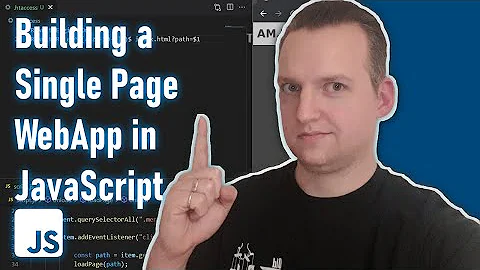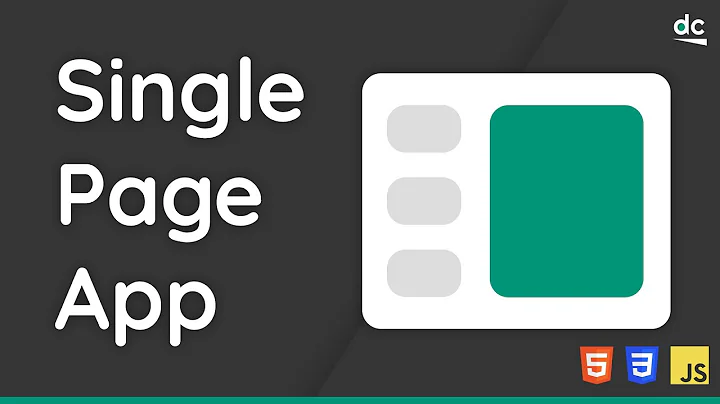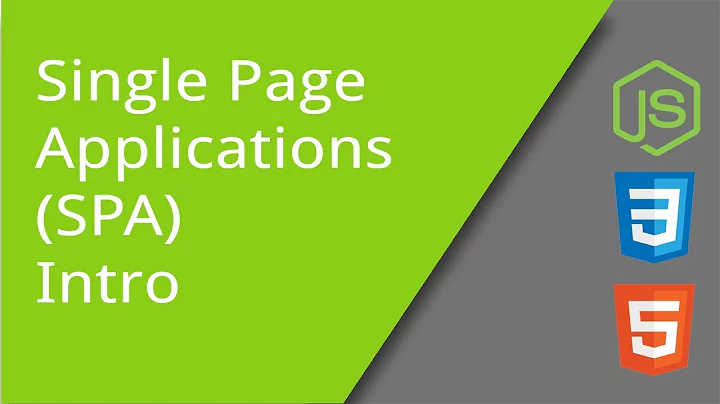Architecture of a single-page JavaScript web application?
Solution 1
MVC architecture of PureMVC/JS is the most elegant IMO. I learned a lot from it. I also found Scalable JavaScript Application Architecture by Nicholas Zakas helpful in researching client side architecture options.
Two other tips
- I've found view, focus, and input management are areas that need special attention in single page web apps
- I also found it helpful to abstract away the JS library, leaving door open to change mind on what you use, or mix & match should the need arise.
Solution 2
Nicholas Zakas's presentation as shared by Dean is a very good place to start with. I was also struggling to answer the same question for a while. After doing couple of large scale Javascript products, thought of sharing the learnings as a reference architecture in case someone needs it. Have a look at:
It addresses common Javascript development concerns such as:
- Solution structuring
- Creating complex module hierarchy
- Self contained UI components
- Event based inter module communication
- Routing, History, Bookmarking
- Unit Testing
- Localization
- Document Generation
etc.
Solution 3
Question - What makes an application complex ?
Answer - The use of word 'complex' in the question itself. Hence, a common tendency will be to look out for a complex solution right from the beginning.
Question - What does the word complex means ?
Answer - Anything that is unknown or partially understood. Example : The theory of Gravity even today is COMPLEX to me but not to Sir Isaac Newton who discovered it in 1655.
Question - What tools can I use to deal with complexity ?
Answer - Understanding and simplicity.
Question - But I understand my application . Its still complex ?
Answer - Think twice, because understanding and complexity does not co-exist. If you understand a huge huge application, I am sure you will agree that it is nothing but an integration of small and simple units.
Question - Why all of the above philosophical discussion for a question on
Single Page Application (SAP)?
Answer - Because,
-> SPA is not some kind of core technology that is newly invented for which we need to reinvent the wheel for a lot of things that we are doing in application development.
-> Its a concept driven by the need for better performance, availability, scalability and maintainability of web applications.
-> Its a fairly newly identified design pattern, so an understanding of SPA as a design pattern goes long way in making informed decisions about the architecture of a SPA.
-> At the root level no SPA is complex, because after understanding the needs of an application and the SPA pattern, you will realize that you are still creating an application, pretty much the same way you did before with some modifications and re-arrangements in the development approach.
Question - What about the use of Frameworks ?
Answer - Frameworks are boiler plate code / solution for some commonly identified and generic patterns, hence they can take off x% (variable, based on the application) load from application development but then not a lot should be expected out of them specially for heavy and growing applications. Its always a good case to be in complete control of your application structure and flow but most importantly the code for it. There should be no grey or black areas in the application code.
Question - Can you suggest one of the many approaches to SPA architecture ?
Answer - Think of your own framework based on the nature of your application. Categorize application components. Look for an existing framework that is close to your derived framework, if you find it then use it, if you do not find it then I suggest going ahead with your own. Creating framework is quite an effort upfront but produces better results in long run. Some basic components in my SPA framework will be:
Data Source : Models / Collections of Models
Mark Up for presenting data : Templates
Interaction with the application : Events
State capturing and navigation : Routing
Utilities , widgets and plug-ins : libraries
Let me know if this helped in any way and good luck with your SPA architecture !!
Solution 4
The way I build apps:
- ExtJS framework, single page app, every component defined in a separate JS file, loaded on-demand
- Every component contacts its own dedicated web service (sometimes more than one), fetching data into ExtJS stores or special-purpose data structures
- The rendering uses standard ExtJS components, so I can bind stores to grids, load forms from records, ...
Just choose a javascript framework, and follow its best practices. My favorites are ExtJS and GWT, but YMMV.
Do NOT roll your own solution for this. The effort required to duplicate what modern javascript frameworks do is too big. It is always faster to adapt something existing than to build it all from scratch.
Solution 5
The best thing to do is to look at example uses of other frameworks:
TodoMVC showcases many many SPA frameworks.
Related videos on Youtube
Admin
Updated on May 15, 2020Comments
-
 Admin almost 4 years
Admin almost 4 yearsHow should a complex single-page JS web application be structured on the client-side? Specifically I'm curious about how to cleanly structure the application in terms of its model objects, UI components, any controllers, and objects handling server persistence.
MVC seemed like a fit at first. But with UI components nested at various depths (each with their own way of acting on/reacting to model data, and each generating events which they themselves may or may not handle directly), it doesn't seem like MVC can be cleanly applied. (But please correct me if that's not the case.)
--
(This question resulted in two suggestions of using ajax, which is obviously needed for anything other than the most trivial one-page app.)
-
Romain about 13 yearsYou can try angularJS or backboneJS
-
 Adrian Moisa over 8 yearsCan you provide your own insights for this question? It's been a while since you asked this question and I'm interested to know what are the most important aspects you learned from your own experience with Javascript SPAs.
Adrian Moisa over 8 yearsCan you provide your own insights for this question? It's been a while since you asked this question and I'm interested to know what are the most important aspects you learned from your own experience with Javascript SPAs.
-
-
SimplGy about 13 yearsjQuery can be written (like any JS) in a namespaced way using prototypes. I'm not sure it's a large or obscure enough feature to warrant abstracting behind a framework--I prefer to learn what JS is actually doing. stackoverflow.com/questions/881515/…
-
 Sam Shiles almost 12 yearsJQuery is not intended as a client side application framework. It is targeted at a "lower-level" than that. JQuery is design to simplify HTML document traversing, event handling, animating, and Ajax operations and to abstract away differences between the browsers. For larger apps you should use a client side application framework such as knockout or backbone IN CONJUNCTION WITH JQuery.
Sam Shiles almost 12 yearsJQuery is not intended as a client side application framework. It is targeted at a "lower-level" than that. JQuery is design to simplify HTML document traversing, event handling, animating, and Ajax operations and to abstract away differences between the browsers. For larger apps you should use a client side application framework such as knockout or backbone IN CONJUNCTION WITH JQuery. -
eaglestorm almost 12 yearsSo my point still stands if knockout or backbone don't include, document traversing, event handling, etc then there not worth much. The YUI3 App Framework does and there is no need for JQuery if you use it.
-
ARF over 11 yearsjquery keeps all its methods stored in the jQuery variable and the $ variable. If you use the no conflict option only the name jQuery is created in the global namespace. jQuery is not a framework, just a library, it doesn't tell you how to do things, just give some shortcuts to do some common stuff. Comparing jQuery to Dojo/ YUI etc is wrong.
-
John Lehmann about 11 years@eaglestorm Your if statement evaluates false.
-
Cody over 10 yearsThis adds some great perspective (that's usually rare). Thx!
-
saaj over 9 yearsI have no doubt jQuery has once changed the web for good, but I agree with @eaglestorm. jQuery has everything in since namespace
$orjQuery, including DOM manipulation, networking, string trimming, and 3rd party extension, which is a poor design. API is messy. But what's really important for an OO application is context management. jQuery event handler'sthisis the event target, not object itself. There's no 3rd argument, like inArray.prototype.mapto specify context. So every event handler ends up withFunction.prototype.bindor$.proxy. Thus it's limited for ad hoc scripts. -
 Qiulang almost 3 yearsIt has changed to github.com/99x/boilerplatejs. But it has been updated for 9 years so I doubt it is still valid.
Qiulang almost 3 yearsIt has changed to github.com/99x/boilerplatejs. But it has been updated for 9 years so I doubt it is still valid.








